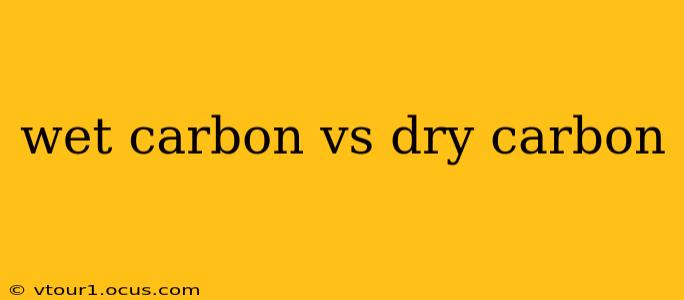Choosing between wet and dry carbon fiber for your next project—be it a high-performance bicycle frame, a sleek sports car body, or a sophisticated piece of aerospace equipment—requires a thorough understanding of their differences. This comprehensive guide will delve into the nuances of wet and dry carbon fiber processes, highlighting their respective strengths and weaknesses. We'll also address some frequently asked questions to help you make an informed decision.
What is Wet Carbon?
Wet layup, the process used to create wet carbon fiber components, involves manually placing layers of dry carbon fiber fabric into a mold. A resin is then applied to the fabric, saturating it completely. This process requires skilled technicians to ensure proper fiber orientation and resin distribution to avoid voids and maintain consistent material properties. The entire assembly is then cured under pressure and heat, solidifying the resin and creating a strong, lightweight composite.
Advantages of Wet Carbon:
- Cost-effectiveness: Wet layup generally requires less expensive equipment than dry layup, making it a more affordable option, particularly for smaller production runs or custom projects.
- Design Flexibility: Wet layup lends itself well to complex shapes and intricate designs. It's easier to adapt the process to unique geometries.
- Repair-ability: Wet carbon components can often be repaired more easily than dry carbon components, especially minor damage.
Disadvantages of Wet Carbon:
- Labor Intensive: The manual nature of wet layup makes it labor-intensive and time-consuming, which can impact production time and overall costs.
- Consistency Challenges: Achieving consistent material properties across multiple parts can be difficult due to the manual nature of the process. Variations in resin saturation and fiber orientation can affect the final product's strength and performance.
- Higher Resin Content: Wet layup typically results in a higher resin content compared to dry layup, potentially leading to a slightly heavier and less stiff component.
What is Dry Carbon?
Dry layup, also known as prepreg carbon fiber, uses pre-impregnated carbon fiber fabrics that already contain a precisely measured amount of resin. These fabrics are placed in a mold and cured under heat and pressure. The process is more automated and controlled than wet layup, resulting in more consistent and repeatable results.
Advantages of Dry Carbon:
- High Strength-to-Weight Ratio: Dry carbon components typically exhibit higher strength and stiffness due to the precise control of resin content and fiber orientation.
- Consistent Quality: The automated nature of dry layup ensures consistent material properties across multiple parts, leading to more reliable performance.
- Faster Curing Times: Dry layup often requires shorter cure times compared to wet layup.
Disadvantages of Dry Carbon:
- Higher Initial Cost: The pre-impregnated fabrics are more expensive than dry fabrics, and specialized equipment is often required for dry layup, leading to higher initial costs.
- Less Design Flexibility: Dry layup can be more challenging for highly complex geometries. The pre-impregnated fabrics may not conform easily to intricate shapes.
- More Difficult Repairs: Repairs on dry carbon components are generally more challenging and require specialized expertise.
Which is Stronger: Wet or Dry Carbon?
Generally, dry carbon is considered stronger and stiffer than wet carbon. This is primarily due to the precise control over resin content and fiber orientation in the dry layup process. However, the strength and stiffness of both types of carbon fiber components depend heavily on factors like the quality of the materials used, the manufacturing process, and the final design.
What is the Difference in Weight Between Wet and Dry Carbon?
While both are lightweight, dry carbon components tend to be lighter than wet carbon components due to the lower resin content. This weight difference can be significant in applications where weight is a critical factor, such as aerospace and high-performance sports equipment.
Which is Better for Automotive Applications?
The choice between wet and dry carbon for automotive applications depends on factors like production volume, budget, and design complexity. For high-volume production, where consistency and efficiency are paramount, dry carbon is often preferred. For low-volume production or custom designs, wet carbon might be a more viable option.
Is Dry Carbon Worth the Extra Cost?
The additional cost of dry carbon is often justified by the superior strength, stiffness, and consistency of the final product. However, this decision ultimately depends on the specific application and its requirements. If high performance and consistent quality are critical, the extra cost of dry carbon may be well worth the investment. For less demanding applications, wet carbon can provide a cost-effective alternative.
This detailed comparison should equip you with a better understanding of the key differences between wet and dry carbon fiber, enabling you to make a more informed choice for your specific needs. Remember to always consult with experts in carbon fiber manufacturing for guidance on your project.
